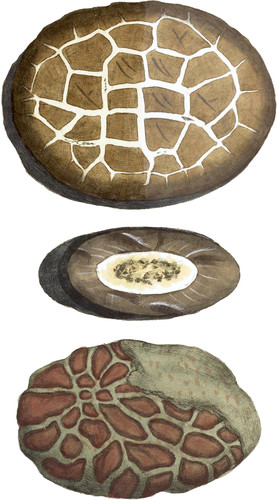 Enlarge
Enlarge
British Mineralogy
Argillaceous Iron Ore
- Class 3. Metals.
- Order 2. Mixed.
- Gen. 7. Iron.
- Spec. 1. Argillaceous.
- Div.
- Syn.
- Common argillaceous Iron-stone. Kirw. v. 173.
- Lowland Iron Ore. Bab. 199.
Among other iron ores a great deal of the sort above figured is used. It is chiefly iron mixed with clay, producing 30 to 50 per cent. as we have heard. This variety is admired for its being divided into polygonal columns by calcareous spar. It is found in round or compressed lumps, called by the miners cats’ heats or cats’ scalps.
It appears that the iron clay in lumps has cracked internally, and that calcareous earth has crystallized in the fissures*. The upper figure shows it as it commonly appears when cut. Bitumen is sometimes contained in the cracks, as are various other substances. In the middle figure the calcareous spar is mixed with blend, and is more concentrated. It was brought to me from Scotland by Dr. Peter Murray.
The lower figure is similar to the uppermost, except being externally in a state of decomposition, probably from exposure to the atmosphere among the tumblers (as they call the stones in common) in the river Tees. We received it from the Rev. Mr. Harriman. Its redness is caused by the oxygenization of its iron. The outside is so far decayed as to expose the divisions of carbonate of lime. These are called septariums, of which theere are various sorts; and besides those of iron stones there are to be found some of marle of various sizes, at Bristol, the Isle of Sheppy, Richmond, and many other places.
The sort in the upper figure is often so much admired after being split that it is frequently cut and polished. The fracture is conchoidal, earthy, and the component parts more or less regular in their mixture, holding
- Iron,
- Clay,
- Lime,
- Silex, and
- Manganese.
- * These divisions depend on the vicissitudes of wet and dry, hot and cold, and approach to the nature of the Giant’s causeway in Ireland, &c.

